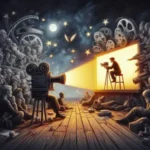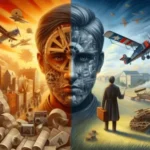Cinema has long been a mirror reflecting the complexities of the human experience, capturing our joys, sorrows, triumphs, and struggles in vivid detail.
From the earliest flickering images to today’s high-definition spectacles, films have evolved not just as a form of entertainment but as a powerful medium for exploring the depths of the human condition. In this blog post, we will embark on a captivating journey through the history of cinema, examining how filmmakers have used storytelling to delve into themes of love, loss, identity, and resilience. We will reflect on iconic films that have stirred our emotions and sparked critical conversations, revealing the profound impact of cinema on our understanding of ourselves and each other. Join us as we uncover the transformative power of the silver screen and its ability to evoke empathy, challenge societal norms, and illuminate the shared experiences that unite us all.
1. Introduction: The Power of Film in Reflecting Humanity
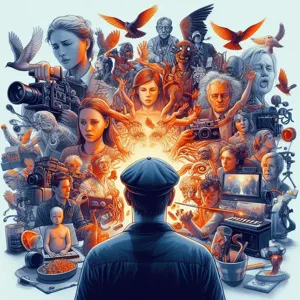
Film has always held a mirror to society, capturing the myriad complexities of the human experience with an artistry that transcends language and borders. From the earliest flickers of silent films to the latest digital masterpieces, cinema has the unique ability to evoke emotions, provoke thoughts, and inspire change. It is a powerful medium, not just for entertainment but for storytelling that delves deep into the essence of what it means to be human.
As we sit in the darkened theaters or curl up on our couches, we find ourselves transported into different worlds, often confronting our own realities through the narratives unfolding on screen. Whether it’s the heartwarming tales of love and friendship, the harrowing struggles against adversity, or the more profound existential questions about life and death, film encapsulates the spectrum of human emotions.
Through the lens of filmmakers, we witness reflections of societal issues, cultural shifts, and even personal dilemmas that resonate with audiences on a universal level. Each frame, each dialogue, and each performance weaves together a tapestry of shared human experiences that invites us to explore our own identities and beliefs.
In this exploration of cinema’s journey through the human condition, we will delve into how films serve as both a reflection and a catalyst for understanding ourselves and the world around us. Join me as we embark on this cinematic journey, celebrating the power of film to illuminate the depths of human nature and foster connections that span across time and space.
2. A Brief History of Cinema and its Evolution
Cinema, often hailed as the seventh art, has undergone a remarkable transformation since its inception in the late 19th century. It began as a curious spectacle, a series of moving images projected onto a screen, captivating audiences with its novelty. The Lumière brothers’ first public screening in 1895 marked the dawn of a new era, where simple vignettes of everyday life mesmerized viewers and sparked an insatiable appetite for storytelling through this vibrant medium.
As the years progressed, cinema evolved beyond mere visual novelty. The silent film era, characterized by its exaggerated expressions and intertitles, allowed filmmakers like Charlie Chaplin and Buster Keaton to explore complex themes of love, loss, and resilience without the use of dialogue. This period was pivotal in establishing cinema as a powerful storytelling tool, capable of conveying deep emotions that resonated with audiences worldwide.
With the advent of synchronized sound in the late 1920s, cinema experienced another monumental shift. The introduction of “talkies” opened up new dimensions for storytelling, enabling filmmakers to incorporate dialogue, music, and sound effects, thus enriching the narrative experience. Icons like Al Jolson in “The Jazz Singer” not only showcased this innovation but also heralded a new era where musicals and dialogue-driven films became the norm.
The mid-20th century saw cinema embrace color and technical advancements, resulting in visually stunning masterpieces that enhanced the audience experience. Directors like Alfred Hitchcock and Orson Welles pushed the boundaries of storytelling, experimenting with narrative structures and psychological depth, while the emergence of genres such as film noir and science fiction reflected the complexities of the human condition in a rapidly changing world.
In the latter half of the 20th century and into the 21st, cinema has continued to evolve, adapting to cultural shifts and technological advancements. From the rise of independent films to the blockbuster phenomenon, filmmakers have explored diverse narratives that challenge societal norms and provoke thought. The digital revolution has further transformed the landscape, allowing for greater accessibility and experimentation, as filmmakers harness the power of digital technology to create immersive experiences.
Today, cinema stands as a mirror reflecting the multifaceted nature of the human condition. It invites viewers into a realm where emotions intertwine with stories, encouraging self-reflection and connection. As we navigate the complex tapestry of life, the journey of cinema serves as a testament to our shared experiences, reminding us of our capacity for empathy, understanding, and transformation.
3. The Role of Storytelling in Film
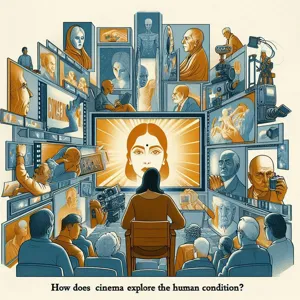
Storytelling lies at the very heart of cinema, acting as the thread that weaves together the fabric of the human experience. From the earliest flickering images on the silent screen to today’s sophisticated blockbusters, the narratives crafted by filmmakers have the power to resonate deeply with audiences, capturing the complexities of love, loss, joy, and despair. Each story, whether a sweeping epic or an intimate character study, offers a mirror reflecting the myriad emotions that define our existence.
At its core, storytelling in film serves as a vehicle for empathy. When we watch a character navigate life’s challenges, we are invited to step into their shoes, to experience their triumphs and tribulations. This transformative aspect of storytelling allows us to confront our own fears and aspirations, broadening our understanding of humanity. Films like “Schindler’s List” and “The Pursuit of Happyness” delve into the depths of despair and resilience, making poignant statements about the human condition that linger long after the credits roll.
Moreover, storytelling in film transcends cultural boundaries, connecting people from diverse backgrounds through universal themes. Whether it’s the struggle for identity depicted in “Moonlight” or the exploration of familial bonds in “The Farewell,” these narratives tap into shared emotions and experiences, fostering a sense of community among viewers. This is the magic of cinema; it can unite us, reminding us that despite our differences, we all grapple with similar joys and sorrows.
As technology continues to evolve, so too do the methods of storytelling. The rise of streaming platforms has given rise to innovative narrative structures and formats, allowing for deeper character development and more intricate plots. Series like “The Crown” and “Breaking Bad” have embraced long-form storytelling, offering viewers a chance to immerse themselves fully in the characters’ lives over several episodes. This evolution reflects the ongoing quest to explore the human condition in ways that resonate with contemporary audiences.
In essence, the role of storytelling in film is a celebration of our shared humanity. It challenges us to reflect on our lives, encourages dialogue about our experiences, and ultimately fosters a greater understanding of one another. As we continue to witness the evolution of cinema, one thing remains clear: the power of a compelling story can illuminate the darkest corners of our existence, reminding us that we are all part of this intricate tapestry of life.
4. Themes of Love and Relationships in Cinema
When we think about the intricate tapestry of human experiences, love and relationships are undeniably at its core. Cinema, as a powerful medium, has artfully captured this complexity, offering audiences a mirror to their own lives and emotions. From the passionate embraces in classic romances to the quiet heartache of separation, films have explored love in its myriad forms, showcasing not just the ecstasy of connection but also the pain of loss and betrayal.
Throughout the decades, cinematic portrayals of love have evolved, reflecting societal changes and the shifting dynamics of relationships. In the early days of film, love stories were often idealized, presenting a fairy-tale version of romance where protagonists overcame all obstacles to find happiness. Think of the enchanting dance sequences of Fred Astaire and Ginger Rogers or the poignant longing captured in films like “Casablanca.” These narratives painted love as a noble pursuit, where true love conquers all.
As we moved into the modern era, filmmakers began to peel back the layers of romantic relationships, presenting them with a rawness and authenticity that resonates with today’s audience. Films like “Eternal Sunshine of the Spotless Mind” delve into the complexities of love and memory, exploring how past relationships shape who we are. Similarly, movies like “Marriage Story” lay bare the emotional turmoil of separation, providing an unflinching look at the fragility of human connections.
Moreover, cinema has embraced diverse representations of love, showcasing LGBTQ+ relationships and the unique challenges they face. Films like “Moonlight” and “Call Me by Your Name” highlight the beauty and struggle of love in contexts that were once marginalized, inviting audiences to empathize with experiences outside their own.
Ultimately, themes of love and relationships in cinema serve as a poignant reminder of our shared humanity. Through laughter, tears, and everything in between, filmmakers invite us to reflect on our own lives, encouraging us to cherish the connections we forge, learn from our heartaches, and embrace the ever-evolving landscape of love. Whether it’s the thrill of new romance or the quiet comfort of companionship, cinema remains a powerful lens through which we can explore the depths of the human condition.
5. Exploring Pain and Suffering Through Film
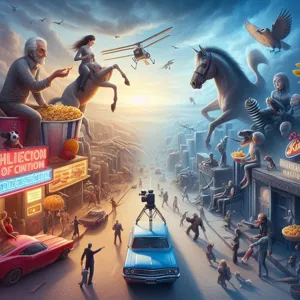
Film has a unique ability to delve into the depths of human emotion, using pain and suffering as a powerful lens through which to explore the complexities of the human experience. From the raw, visceral portrayals of tragedy to the subtle, nuanced representations of heartache, cinema invites audiences to confront their own vulnerabilities and empathize with the struggles of others.
Consider the haunting imagery of a character grappling with loss, their world slowly unraveling in front of our eyes. The director’s choice of lighting, the melancholic score, and the poignant dialogue all work in harmony to create a profound impact, forcing viewers to sit with their discomfort and reflect on their own lives. Films like “Schindler’s List” or “Atonement” do more than tell a story; they evoke a visceral response, allowing us to experience the weight of sorrow, regret, and despair alongside the characters.
Moreover, pain is not merely depicted for its own sake; it serves as a catalyst for growth, resilience, and ultimately, redemption. The journey through suffering often leads to a transformative experience, highlighting the strength of the human spirit. Movies like “The Pursuit of Happyness” illustrate this beautifully, showing how struggle can breed determination and hope.
As we explore pain and suffering through film, we are reminded that these themes are universal. They resonate across cultures and time periods, uniting us in our shared humanity. Cinema holds up a mirror to our lives, reflecting not only our sorrows but also our capacity for healing and connection. In this way, films become not just a source of entertainment but a profound means of understanding ourselves and each other, making us more compassionate beings in an often fractured world.
6. The Quest for Identity: How Cinema Mirrors Self-Discovery
Cinema has long served as a powerful medium for exploring the intricate tapestry of human identity. From the moment the lights dim and the screen flickers to life, audiences are drawn into a world where characters grapple with existential questions, confront personal demons, and embark on transformative journeys of self-discovery. This quest for identity is not just a subplot; it resonates deeply with viewers, reflecting their own struggles and triumphs in a society that often feels fragmented and chaotic.
Films like “The Graduate” and “Moonlight” poignantly capture the nuances of this search, illustrating how culture, environment, and personal experiences shape our understanding of who we are. In “The Graduate,” Benjamin Braddock’s journey encapsulates the disillusionment of a generation, navigating the expectations of adulthood while seeking genuine connection. Similarly, “Moonlight” offers a profound exploration of identity through the lens of race, sexuality, and class, inviting audiences to empathize with the complexities of self-acceptance.
Moreover, the visual language of cinema enhances these narratives, employing symbolism, color, and cinematography to deepen the emotional resonance of the characters’ journeys. The use of mirrors, for instance, is a recurring motif that signifies introspection and the often painful realization of one’s true self. As audiences witness characters confront their pasts, make difficult choices, and ultimately embrace their authentic selves, they are encouraged to reflect on their own identities and the societal constructs that influence them.
The quest for identity in cinema is not confined to dramatic narratives; it also thrives in the realm of animation and fantasy. Films like “Inside Out” and “Spirited Away” delve into the complexities of the human psyche, offering relatable characters that navigate their emotions and environments. These stories remind us that the journey of self-discovery is universal, transcending cultural boundaries and inviting viewers of all ages to engage with their inner selves.
In this way, cinema becomes a mirror, reflecting not only the journeys of its characters but also the diverse experiences of its audience. As we sit in darkened theaters or cozy up on our couches, we find solace in the fact that we are not alone in our quest for identity. Through the lens of film, we are reminded of our shared humanity, the struggles we face, and the beauty of embracing who we truly are. As we continue to explore the depths of the human condition through cinema, we uncover the profound truths that unite us all in this intricate dance of self-discovery.
7. Social Issues and Cinema: A Reflection of Society
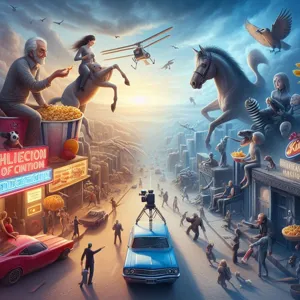
Cinema has long served as a mirror to society, reflecting its triumphs, struggles, and the myriad social issues that shape our collective experience. From the groundbreaking films of the 1960s that tackled civil rights and gender equality to contemporary narratives addressing climate change and mental health, the silver screen has become a powerful platform for raising awareness and fostering dialogue.
Consider how films like “12 Years a Slave” and “Spotlight” not only entertain but educate audiences about historical injustices and systemic corruption. These stories compel viewers to confront uncomfortable truths, while simultaneously offering insight into the resilience of the human spirit. The emotional weight of such films can lead to a profound understanding of societal problems, encouraging empathy and action among audiences.
Moreover, the rise of independent cinema has further diversified the portrayal of social issues, allowing marginalized voices and stories to emerge that might otherwise be overlooked in mainstream narratives. Films like “Moonlight” and “The Farewell” explore themes of identity, belonging, and familial love, all while shining a light on the complexities faced by underrepresented communities. Through their lens, we gain a deeper appreciation for the nuances of the human condition, fostering a sense of connection across cultures and experiences.
As cinema continues to evolve, so too does its role as a societal commentator. The blending of entertainment and activism is increasingly evident, with filmmakers using their craft to champion causes and inspire change. Documentaries like “An Inconvenient Truth” and “The Act of Killing” challenge viewers to engage with pressing issues, proving that the power of film extends far beyond the walls of the theater.
In essence, cinema not only entertains; it has the potential to shape societal narratives and provoke critical thought. By reflecting the complexities of the human condition and the social issues we face, films can inspire us to reflect on our values, question our beliefs, and ultimately, take action toward a more just and equitable world.
8. The Impact of Cultural Context on Film Narratives
Cultural context plays a pivotal role in shaping film narratives, weaving intricate layers of meaning that resonate deeply with audiences. Every film is a product of its time, reflecting the societal norms, values, and struggles of the era in which it was created. From the roaring twenties’ exuberance depicted in silent films to the gritty realism of post-war cinema, each period brings its unique lens through which stories are told.
Take, for instance, the powerful influence of cultural movements such as feminism, civil rights, and LGBTQ+ advocacy. Films born from these movements do more than entertain; they challenge prevailing attitudes and encourage dialogue by placing marginalized voices at the forefront. Consider the poignant storytelling in films like “Moonlight” or “The Color Purple,” which not only depict personal struggles but also serve as cultural commentaries highlighting systemic injustices.
Moreover, cultural context extends beyond just the narrative; it encompasses visual aesthetics, sound choices, and character development. A film set in the vibrant streets of Tokyo will utilize a markedly different stylistic approach compared to one set in the rural American South, as each location carries its own historical and cultural weight. This geographical distinction influences everything from dialogue and costume design to the very pacing of the story, creating rich tapestries that capture the essence of their respective cultures.
Directors and screenwriters often draw inspiration from their own backgrounds, imbuing their work with personal experiences that resonate within broader cultural frameworks. This intersection of individual and collective narratives not only enriches the film but fosters a deeper connection with audiences who see their own experiences reflected back at them.
In today’s globalized world, the exchange of cultural narratives has become even more pronounced. Films like “Parasite,” which masterfully critiques capitalism and class disparity in South Korea, have transcended borders, inviting international audiences to engage with themes that, while specific to one culture, echo universal human experiences.
Ultimately, the impact of cultural context on film narratives underscores the power of cinema as a mirror to society. It serves as a reminder that every story is part of a larger dialogue, one that reflects our shared humanity and the diverse tapestry of our world. As filmmakers continue to explore and challenge cultural contexts, they ensure that cinema remains a vital space for understanding the complexities of the human condition.
9. Iconic Films That Shaped Our Understanding of the Human Condition
Cinema has an extraordinary ability to mirror the complexities of human existence, encapsulating emotions, struggles, and triumphs in ways that resonate deeply with audiences. Throughout the decades, certain films have emerged not just as entertainment but as profound explorations of the human condition, offering insights that shape our understanding of ourselves and the world around us.
One of the most iconic films in this regard is *Schindler’s List* (1993), directed by Steven Spielberg. This haunting portrayal of the Holocaust goes beyond historical recount; it delves into themes of morality, sacrifice, and the capacity for both good and evil within humanity. Through the lens of Oskar Schindler’s transformation from a profiteer to a savior, the film forces viewers to confront uncomfortable truths about human nature and the impact of individual choices in the face of monumental atrocities.
Similarly, *The Shawshank Redemption* (1994) explores hope and resilience against the backdrop of despair. The journey of Andy Dufresne, an innocent man wrongfully imprisoned, serves as a testament to the strength of the human spirit. Its poignant message—that hope is a powerful force, even in the bleakest of circumstances—resonates universally, reminding us of our capacity to endure and find purpose, no matter how dire our situation may seem.
Another landmark film, *12 Angry Men* (1957), offers a compelling examination of justice, prejudice, and the intricacies of human relationships. Set almost entirely in a jury room, the film skillfully unravels the biases and moral dilemmas faced by each juror, showcasing how personal experiences can shape one’s perspective. This gripping narrative not only highlights the importance of empathy and critical thinking but also reflects on the societal structures that influence our understanding of fairness and truth.
Likewise, *Eternal Sunshine of the Spotless Mind* (2004) invites viewers to ponder the nature of love and memory. Through the story of Joel and Clementine, who undergo a procedure to erase painful memories of each other, the film articulates the bittersweet complexities of relationships. It raises profound questions about identity and the role of pain in our emotional landscape, challenging us to embrace our experiences—both joyful and sorrowful—as integral to who we are.
These films, among many others, have left an indelible mark on cinema and culture, shaping our collective consciousness. They serve as reminders that through the lens of storytelling, we can explore the depths of the human condition, confront our fears, celebrate our joys, and ultimately find a deeper connection to one another. As we reflect on these cinematic masterpieces, we are encouraged to continue the dialogue about what it means to be human in an ever-evolving world.
10. The Emotional Connection: Why We Relate to Film Characters
At the heart of cinema lies an intricate tapestry of emotions that resonates deeply with the human experience. The emotional connection we feel towards film characters is not mere happenstance; it is a reflection of our own lives, aspirations, and vulnerabilities. When we sit in a darkened theater, enveloped by the flickering light of the screen, we often find ourselves drawn into the lives of these larger-than-life figures, experiencing their joys, sorrows, triumphs, and failures as if they were our own.
This connection is forged through relatable storytelling and authentic performances. Screenwriters and directors craft narratives that mirror the complexities of our existence—love, loss, fear, and hope. Characters are often imbued with traits that echo our own, creating a bridge between the audience and the screen. Whether it’s the quiet strength of a protagonist overcoming adversity or the relatable struggles of a flawed antihero, these portrayals evoke empathy, encouraging us to reflect on our own journeys.
Consider the heart-wrenching tale of a character grappling with loss. As we witness their pain, we may recall our own experiences of grief, allowing us to dive into a shared emotional pool that transcends the boundaries of time and space. This cathartic release, often referred to as “emotional catharsis,” serves not only to entertain but to heal, providing a safe space to explore the depths of our feelings.
Furthermore, the visual and auditory elements of film amplify this connection. The score swells at pivotal moments, heightening our emotional response, while cinematography captures the subtleties of a character’s expression. Each frame is meticulously designed to draw us closer, inviting us to invest in the narrative on a visceral level.
Ultimately, our affinity for film characters is a testament to the power of storytelling. In a world where we often feel isolated in our struggles, cinema offers a communal experience—a reminder that we are not alone in our feelings. It reflects our humanity, allowing us to explore the full spectrum of emotions and, in doing so, deepening our understanding of ourselves and each other. As we navigate the complexities of life, these cinematic connections become a mirror, reflecting our innermost thoughts and emotions, and reminding us of the shared human condition that binds us all.
11. Directors and Their Unique Perspectives on Humanity
In the ever-evolving landscape of cinema, directors stand as the architects of storytelling, each bringing their unique lens through which to explore the complexities of the human condition. Their personal experiences, cultural backgrounds, and philosophical beliefs shape the narratives they choose to tell, resulting in a rich tapestry of films that reflect our shared humanity.
Consider the poignant works of directors like Federico Fellini, whose surreal storytelling captures the paradoxes of joy and sorrow inherent in life. His films often blend fantasy and realism, inviting audiences to confront the whimsical yet painful truths of existence. Similarly, the spare, minimalist approach of director Andrei Tarkovsky emphasizes introspection and spiritual exploration, urging viewers to ponder the nature of time, memory, and faith.
On the other end of the spectrum, the vibrant and often chaotic storytelling style of Quentin Tarantino provides a stark examination of violence and redemption, forcing audiences to grapple with moral ambiguity and the consequences of choice. His films, rich with dialogue and cultural references, serve not only as entertainment but as a mirror reflecting society’s darker aspects.
As we delve into the works of these visionary filmmakers, we discover how their unique perspectives illuminate the diverse experiences of humanity. Whether through the lens of tragedy, comedy, or a blend of both, directors invite us to engage with the themes of love, loss, identity, and resilience. With each film, they challenge us to confront our own beliefs and emotions, reminding us that cinema is not just a form of escapism, but a powerful medium for understanding ourselves and the world around us. In essence, these directors do more than create films; they craft profound narratives that resonate with the deepest layers of the human experience.
12. The Future of Cinema: Trends and Their Implications on Human Stories
As we stand on the precipice of a new era in filmmaking, the future of cinema is evolving rapidly, shaped by technological advancements, changing audience expectations, and a broader understanding of diverse human experiences. The rise of streaming platforms has democratized access to films, allowing stories that once languished in the shadows to find their place in the spotlight. This shift not only challenges traditional narratives but also invites a myriad of voices to tell their stories, reflecting a more nuanced and multifaceted portrayal of the human condition.
One of the most significant trends is the integration of immersive technologies, such as virtual reality (VR) and augmented reality (AR). These innovations are transforming the way we experience stories, allowing audiences to step directly into the narrative. Imagine being able to walk alongside characters, witnessing their struggles and triumphs from their perspective. This immersive storytelling could deepen our empathy and understanding, providing a visceral connection to the human experiences depicted on screen.
Moreover, the rise of data analytics is influencing the types of stories being told. Filmmakers can now harness insights into audience preferences, driving the creation of content that resonates on a personal level. While this can lead to the production of more relatable and relevant narratives, it also raises questions about creativity and authenticity. Will filmmakers prioritize market trends over artistic vision, or can they strike a balance that honors both?
As global issues such as climate change, social justice, and mental health take center stage, cinema increasingly reflects these pressing concerns. Filmmakers are using their platforms to spark conversations, challenge societal norms, and inspire action. This trend not only highlights the power of film as a tool for social change but also reaffirms the idea that stories can shape our understanding of the world and our place within it.
In this rapidly changing landscape, the implications for human stories are profound. Cinema has always been a mirror to society, and as it adapts to new realities, it continues to explore the depths of the human condition. The future of cinema promises to be a tapestry woven from diverse perspectives, innovative storytelling techniques, and a commitment to authenticity. As audiences, we can look forward to an exciting journey ahead—one that not only entertains but also challenges, educates, and ultimately connects us in our shared humanity.
13. The Role of Documentaries in Understanding Real-Life Struggles
Documentaries hold a unique place in the cinematic landscape, bridging the gap between storytelling and real-life experiences. Unlike fictional films that often draw from creative imagination, documentaries are grounded in reality, offering viewers an unfiltered glimpse into the complexities of the human condition. They serve as powerful tools for empathy, education, and activism, illuminating real-life struggles that might otherwise remain hidden in the shadows of society.
Through intimate interviews, compelling footage, and immersive narratives, documentaries invite audiences to walk alongside individuals facing adversity, whether it be poverty, illness, social injustice, or the effects of war. For instance, films like “13th,” which explores the racial inequalities within the U.S. prison system, or “Won’t You Be My Neighbor?,” which reflects on the profound impact of Fred Rogers’ kindness, not only educate viewers but also inspire critical conversations about pressing social issues.
In a world often saturated with sensationalized content, documentaries cut through the noise, allowing for a more profound understanding of diverse perspectives. They challenge us to confront uncomfortable truths and expand our worldview, fostering a sense of shared humanity. By showcasing the resilience and strength of individuals navigating their struggles, documentaries not only highlight the severity of these issues but also celebrate the spirit of perseverance that defines the human experience.
As we reflect on the role of documentaries in cinema, it becomes evident that they are not merely a genre of film; they are an essential medium for understanding and empathizing with the myriad challenges people face. In this way, they enrich our collective consciousness, reminding us that every story matters and every voice deserves to be heard. Through these powerful narratives, we gain insights into the resilience of the human spirit, encouraging us to engage with the world around us in meaningful ways.
14. Conclusion: What Cinema Teaches Us About Ourselves
As the curtains draw to a close on our exploration of cinema’s profound impact on the human condition, we are left with a tapestry of reflections that illuminate the intricate layers of our existence. Throughout the ages, film has served as a mirror, reflecting our joys, sorrows, triumphs, and tribulations. It encapsulates the essence of who we are, transcending boundaries of culture, language, and time.
Cinema teaches us that our shared experiences—love and loss, hope and despair—are universal threads that bind us together. Each character, every storyline, resonates with the audience, offering insights into our own lives and challenging us to confront our vulnerabilities. The powerful narratives unfold on screen, encouraging us to empathize with perspectives previously foreign to us, fostering a deeper understanding of the diverse human experience.
Moreover, films often provoke introspection, prompting us to question our values, beliefs, and choices. They inspire conversations that ripple beyond the theater walls, igniting discussions about social justice, identity, and morality. Through the lens of cinema, we are reminded of our capacity for change, growth, and resilience; we see reflections of ourselves in the characters’ journeys, often finding solace and encouragement in their struggles.
As we conclude this journey through the silver screen, it becomes clear that cinema is more than mere entertainment—it is an art form that enriches our lives and deepens our understanding of ourselves and each other. In a world that can sometimes feel disconnected, film serves as a powerful reminder of our shared humanity, urging us to listen, learn, and connect. As we step away from the glow of the projector, let us carry these lessons with us, embracing the rich tapestry of life that cinema continues to unravel.
15. Further Reading: Recommended Films and Books on the Human Condition
Delving deeper into the exploration of the human condition through cinema and literature opens a vast landscape of emotions, philosophies, and narratives that resonate with our shared experiences. For those eager to extend their understanding beyond this blog post, here’s a curated list of films and books that beautifully encapsulate the complexity of human existence.
**Films:**
1. **”Eternal Sunshine of the Spotless Mind” (2004)** – This thought-provoking film blends romance and science fiction, exploring themes of memory, love, and the pain of loss, inviting viewers to contemplate the intricacies of relationships and the essence of personal identity.
2. **”A Beautiful Mind” (2001)** – Based on the life of mathematician John Nash, this biopic presents a profound study of mental illness, genius, and the power of love and resilience, shedding light on the struggles and triumphs that define the human experience.
3. **”The Pursuit of Happyness” (2006)** – A heartwarming tale of perseverance and hope, this film follows a father’s journey through homelessness while striving to provide for his son, illustrating the universal quest for dignity and fulfillment.
4. **”Parasite” (2019)** – This Oscar-winning masterpiece delves into class disparity and the lengths to which people will go to escape their circumstances, offering a sharp critique of society that resonates with contemporary audiences.
5. **”12 Angry Men” (1957)** – A gripping courtroom drama that examines themes of justice, prejudice, and moral responsibility, this film serves as a powerful reminder of the complexities of human nature and the decisions that shape lives.
**Books:**
1. **”Man’s Search for Meaning” by Viktor E. Frankl** – This seminal work intertwines memoir and psychology, offering insights into finding purpose even in the most harrowing situations, as experienced by Frankl during his time in Nazi concentration camps.
2. **”To Kill a Mockingbird” by Harper Lee** – A timeless novel that addresses profound issues of race and morality through the eyes of a child, prompting readers to reflect on their own beliefs and the societal norms that influence them.
3. **”The Road” by Cormac McCarthy** – In this haunting tale of a father and son journeying through a post-apocalyptic world, McCarthy explores themes of survival, love, and the enduring bond between parent and child against the backdrop of despair.
4. **”The Alchemist” by Paulo Coelho** – This philosophical novel encourages readers to pursue their dreams and listen to their hearts, emphasizing the importance of self-discovery and the universal search for meaning in life.
5. **”Braving the Wilderness” by Brené Brown** – A compelling exploration of belonging and authenticity, Brown delves into what it means to truly connect with others and foster a sense of community in a world that often feels isolating.
These films and books not only entertain but also provoke thought and reflection, guiding us to confront our own humanity. Each narrative serves as a mirror, reflecting the myriad experiences that shape our lives, reminding us of the power of storytelling to bridge gaps and foster understanding in the complex tapestry of the human condition. Whether you’re cozying up on the couch with a good movie or curling up with a compelling book, these selections promise to deepen your appreciation for the stories that define us all.
As we draw the curtains on our exploration of cinema’s profound journey through the human condition, we are reminded of the unparalleled power of film to reflect, challenge, and transform our understanding of ourselves and each other. From heart-wrenching dramas to lighthearted comedies, each frame captures a spectrum of emotions that resonate deeply within us, inviting introspection and dialogue. Cinema has continually evolved, mirroring societal changes and amplifying diverse voices, reminding us of our shared experiences and individual struggles. As we move forward, let us carry the lessons learned from the silver screen into our everyday lives, using the art of storytelling to foster empathy, connection, and a deeper appreciation for the beautiful complexity of the human experience. Thank you for joining us on this cinematic journey—may your next movie night be filled with reflections that inspire and ignite your passion for the art of film.



